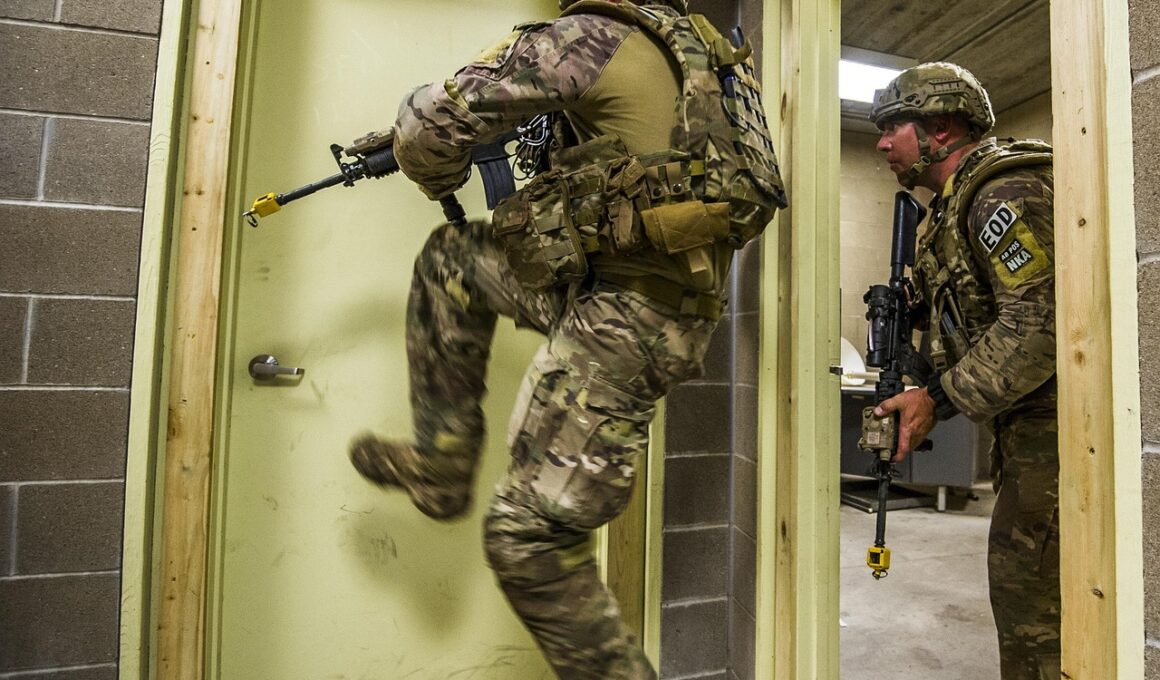The Role of Suspension Training in Military Fitness Programs
Military fitness programs aim to maintain high levels of physical preparedness. This goal is achieved through various methods, one of the most effective being suspension training. Suspension trainers offer versatility, allowing personnel to perform a broad range of exercises using body weight. The core approach involves leveraging gravitational resistance, enhancing not just strength but also coordination and flexibility. By engaging multiple muscle groups, suspension trainers complement conventional strength training. This method is essential for military readiness, as it simulates the demands placed on soldiers. Moreover, exercises can be easily tailored to match individual fitness levels, making them suitable for all warriors. Additionally, suspension training can be performed in diverse settings, from the gym to field deployments. This flexibility means that soldiers can stayfit anytime, anywhere. Consequently, injury risk is minimized since suspension training encourages natural movement patterns. Furthermore, the training necessitates enhanced core stability, vital for combat scenarios. As a result, enhanced athletic performance form the crux of military efficiency, making suspension training indispensable for armed forces today.
Benefits of Using Suspension Trainers
Incorporating suspension trainers into military fitness programs provides numerous advantages. First, they promote superior strength building through essential movements. By allowing exercises like rows and push-ups, suspension trainers help soldiers develop functional strength. These exercises enhance overall body control, crucial in combat situations. The second benefit includes increased muscular endurance from performing high-repetition tasks. Endurance is paramount for soldiers, who frequently face physically demanding situations during missions. Consequently, suspension training engages stabilizing muscles, leading to a stronger core. A robust core supports various physical tasks in the field, ensuring soldiers maintain optimal performance levels. Additionally, suspension training improves flexibility and balance. By engaging in dynamic movements that require stabilization, soldiers become more agile. This agility is key in navigating diverse terrains during missions. Moreover, suspension trainers are often lightweight and portable, meaning that they can be transported easily. Thus, military personnel can carry these trainers wherever they go. Lastly, the functional nature of suspension training translates directly to real-world scenarios soldiers encounter in the field. Preparing them effectively for mission challenges is paramount and secures their safety.
Another aspect of suspension training is its adaptability in diverse environments. Whether in a gym or a remote location, suspension trainers enable soldiers to work out effectively. This adaptability enhances exercise frequency, which is crucial for maintaining physical readiness. It also fosters a culture of fitness within the unit, encouraging camaraderie among soldiers. When personnel train together, motivation levels rise, which benefits overall morale. Furthermore, varying exercises based on individual goals ensures that every soldier develops their strengths through tailored training. For example, specific programs can focus more on strength training while others may emphasize endurance. This ensures every soldier can address their unique challenges effectively. Alongside personal customization, advanced equipment features allow tracking of various fitness metrics. Monitoring progress is essential in achieving fitness goals. Consequently, the use of suspension trainers aids instructors in assessing overall development while integrating new challenges to avoid plateauing. It also allows a level of competitive spirit among comrades, driving them to strive for excellence. These factors cumulatively contribute to building an elite military fitness program.
Effective Exercises for Suspension Training
A variety of exercises can be performed with suspension trainers, providing comprehensive training. Key exercises include the suspension push-up, which develops upper body strength and core stability. This movement specifically targets the chest, shoulders, and triceps while engaging the core evenly. Another beneficial exercise is the row, which strengthens the back and improves posture. By pulling oneself up, soldiers encourage prime muscle engagement, enhancing overall stability. Also notable, the lunge is critical for improving leg strength and flexibility. Soldiers can incorporate rotational lunges that fluctuate movement patterns, better replicating field scenarios. Furthermore, the plank variation challenges core stability and allows for improved trunk strength. A strong trunk is vital for injury prevention during combat situations. Incorporating these exercises ensures balanced development across muscle groups, addressing potential vulnerabilities. As soldiers become proficient in these exercises, progression should include advanced movements to continuously challenge their abilities. Adding functional movements like single-leg exercises enhances athleticism further. Thus, maximizing strength and functionality correlates entirely with performance and safety, highlighting the importance of a thorough exercise regimen.
Moreover, effective suspension training incorporates a well-defined progression plan. Initiating training with basic movements helps lay the groundwork for understanding the fundamentals. As soldiers become comfortable with exercises, advanced variations introduce complexity which enhances muscle engagement. Challenges must align with fitness levels to ensure efficacy and avoid injury. For instance, adjusting the body angle changes resistance, making exercises more or less demanding. By manipulating these variables, instructors can customize workouts effectively. This adaptability encourages growth while ensuring exercises remain engaging. Additionally, incorporating speed and explosive movements can foster improved performance across various fitness components. Higher intensity efforts promote muscle endurance and cardiovascular fitness, critical for military applications during bold engagements. Thus, attentiveness to progression and exercise modification ensures steady improvement for every soldier involved. Furthermore, conducting periodic assessments enables instructors to evaluate progress over time. By assessing fitness levels regularly, military trainers can adapt programs effectively. Proper management of individual goals, strengths, and weaknesses is essential to overall mission success. Following these principles enables military fitness programs to integrate advanced training efficiently and support soldiers adequately.
Conclusion: The Future of Suspension Training
In conclusion, suspension training plays an integral role in military conditioning. Its flexibility, efficiency, and effectiveness make it an ideal fitness solution for soldiers. The emphasis on functional movements directly prepares personnel for the demands of their environments. As military programs continue evolving, integrating suspension training remains a top priority. Enhanced strength, endurance, stability, and flexibility come from utilizing these innovative tools, ensuring troops remain combat-ready. Moreover, the incorporation of group dynamics fosters camaraderie and motivation, essential within military units. As soldiers support each other through shared workouts, their commitment to fitness remains steadfast. The long-term benefits of engaging in suspension training extend beyond the physical. Increased mental resilience accompanies improved fitness levels, preparing soldiers for challenges ahead. As technology advances, so too will the opportunities for innovation within suspension training. Potential solutions may include more dynamic equipment and digital applications that track fitness progress. Embracing these advancements can spearhead more effective military training protocols. Ultimately, the future denotes a growing emphasis on comprehensive functional strategies, ensuring soldiers not only survive on missions but thrive in any setting.
Thus, suspension training is undoubtedly a compelling component of military fitness programs. Its multifaceted advantages equip soldiers to tackle diverse challenges while promoting overall fitness. Commander and trainers must recognize their importance, ally their efforts, and continuously evolve training strategies. Through implementing advanced programs, they can shape more robust, agile, and efficient forces. Encouraging continuous adaptation and the integration of best practices will solidify suspension training’s place in military training landscapes. Fitness adapted through suspension training cultivates warriors prepared for every battle, effectively fortifying teams. Ultimately, such training strategies build resilience against adversaries while strengthening camaraderie among units. By valuing the significance of suspension training, military fitness programs can transform how personnel approach their physical preparations, reflecting a commitment to excellence and preparedness.


